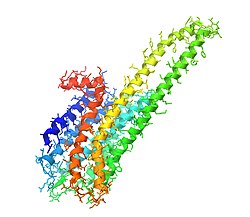Our website is made possible by displaying online advertisements to our visitors.
Please consider supporting us by disabling your ad blocker.
HTR2A
Receptor 5-HT2A je podtip receptora5-HT2 porodice serotononskih G protein-spregnutih receptora (GPCR).[4] Recweptor 5-HT2A je receptor ćelijske površine.[5] 5-HT je skraćenica za 5-hidroksi-triptamin, koji je serotonin. Ovo je glavni podtip ekscitacijskog receptora među GPCR za serotonin, iako 5-HT2A također može imati inhibitorni učinak[6] na određenim područjima kao što su vizuelni i orbitofrontalni korteks.[7] Ovaj receptor je prvi put zapažen po svom značaju kao meta serotonergični psihodelični lijekovi kao što su LSD i psilocibinska gljiva. Kasnije se vratio na vidjelo jer je utvrđeno da je barem djelomično posredovao u djelovanju mnogih antipsihotičnih lijekova, posebno atipskih.
Smanjena regulacija postsinapsnihih receptora 5-HT2A je adaptivni proces izazvan hroničnom primjenom selektivnih inhibitora preuzimanja serotonina (SSRI) i atipskih antipsihotika. Samoubilački i na drugi način depresivni pacijenti imali su više receptora 5-HT2A od normalnih pacijenata. Ovi nalazi ukazuju na to da je postsinapsna prekomjerna gustoća 5-HT2A uključena u patogenezu depresije.[8]
Paradoksalna podregulacija receptora 5-HT2A može se primijetiti s nekoliko antagonista 5-HT 2A.[9] Prema tome, umjesto tolerancije, od antagoniste 5-HT2A očekivala bi se reverzna tolerancija. Međutim, na ovom mjestu postoji barem jedan antagonist za koji je pokazano da poboljšava receptore 5-HT2A.[10] Osim toga, nekoliko drugih antagonista možda neće uticati na broj receptora 5-HT2A.[11] Ipak, nadregulacija je prije izuzetak nego pravilo. Niti tolerancija niti odskok ne primjećuju se kod ljudi s obzirom na SWS koji promovira efekte antagonista 5-HT2A.[12]
- ^ a b c GRCh38: Ensembl release 89: ENSG00000102468 - Ensembl, maj 2017
- ^ "Human PubMed Reference:". National Center for Biotechnology Information, U.S. National Library of Medicine.
- ^ "Mouse PubMed Reference:". National Center for Biotechnology Information, U.S. National Library of Medicine.
- ^ Cook EH, Fletcher KE, Wainwright M, Marks N, Yan SY, Leventhal BL (august 1994). "Primary structure of the human platelet serotonin 5-HT2A receptor: identify with frontal cortex serotonin 5-HT2A receptor". Journal of Neurochemistry. 63 (2): 465–9. doi:10.1046/j.1471-4159.1994.63020465.x. PMID 8035173. S2CID 40207336.
- ^ Kling A (2013). 5-HT2A: a serotonin receptor with a possible role in joint diseases (PDF). Umeå: Umeå Universitet. ISBN 978-91-7459-549-9.
- ^ Martin P, Waters N, Schmidt CJ, Carlsson A, Carlsson ML (1998). "Rodent data and general hypothesis: antipsychotic action exerted through 5-HT2A receptor antagonism is dependent on increased serotonergic tone". Journal of Neural Transmission. 105 (4–5): 365–96. doi:10.1007/s007020050064. PMID 9720968. S2CID 20944107.
- ^ De Almeida RM, Rosa MM, Santos DM, Saft DM, Benini Q, Miczek KA (maj 2006). "5-HT(1B) receptors, ventral orbitofrontal cortex, and aggressive behavior in mice". Psychopharmacology. 185 (4): 441–50. doi:10.1007/s00213-006-0333-3. PMID 16550387. S2CID 33274637.
- ^ Eison AS, Mullins UL (1996). "Regulation of central 5-HT2A receptors: a review of in vivo studies". Behavioural Brain Research. 73 (1–2): 177–81. doi:10.1016/0166-4328(96)00092-7. PMID 8788498. S2CID 4048975.
- ^ Yadav PN, Kroeze WK, Farrell MS, Roth BL (oktobar 2011). "Antagonist functional selectivity: 5-HT2A serotonin receptor antagonists differentially regulate 5-HT2A receptor protein level in vivo". The Journal of Pharmacology and Experimental Therapeutics. 339 (1): 99–105. doi:10.1124/jpet.111.183780. PMC 3186284. PMID 21737536.
- ^ Rinaldi-Carmona M, Congy C, Simiand J, Oury-Donat F, Soubrie P, Breliere JC, Le Fur G (januar 1993). "Repeated administration of SR 46349B, a selective 5-hydroxytryptamine2 antagonist, up-regulates 5-hydroxytryptamine2 receptors in mouse brain". Molecular Pharmacology. 43 (1): 84–9. PMID 8423772.
- ^ Gray JA, Roth BL (novembar 2001). "Paradoxical trafficking and regulation of 5-HT(2A) receptors by agonists and antagonists". Brain Research Bulletin. 56 (5): 441–51. doi:10.1016/s0361-9230(01)00623-2. PMID 11750789. S2CID 271925.
- ^ Vanover KE, Davis RE (28. 7. 2010). "Role of 5-HT2A receptor antagonists in the treatment of insomnia". Nature and Science of Sleep. 2: 139–50. doi:10.2147/nss.s6849. PMC 3630942. PMID 23616706.
Previous Page Next Page







